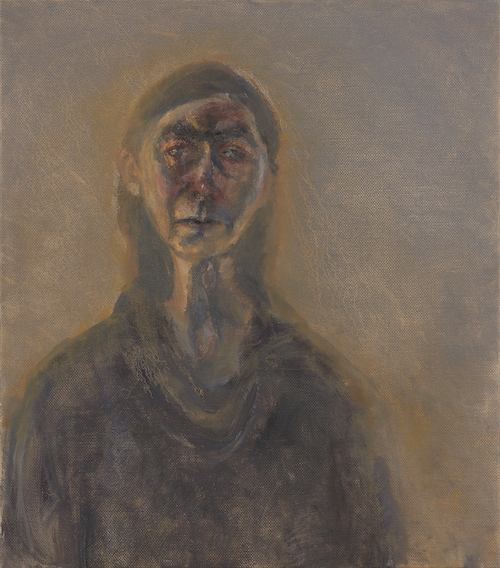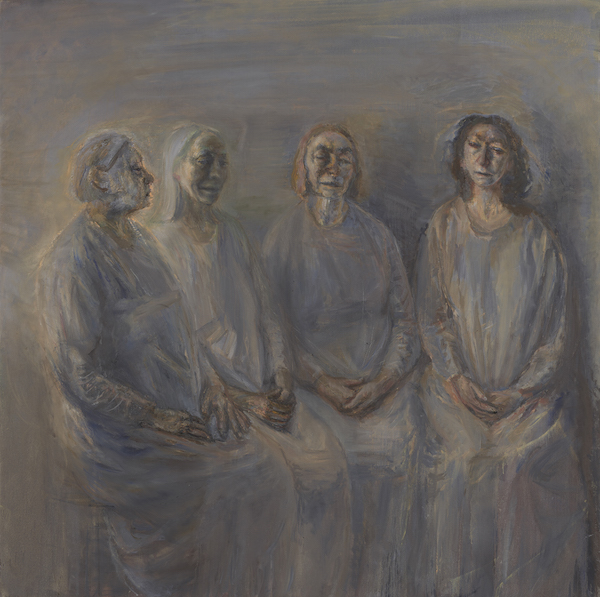Visual Arts Review: The Art of Celia Paul — The Power of Quiet
Celia Paul’s paintings are calm, reflective, and inviting.
Celia Paul at the Yale Center for British Art, New Haven, CT, through August 12.

Celia Paul, “Self-Portrait,” 2017. Photo: courtesy of Yale Center for British Art.
By Kathleen Stone
This exhibition of paintings by Celia Paul is a small show, just six paintings in one gallery plus a seventh hung separately, augmented by a wall of other work that Paul considers to be like-minded: Reynolds and Gainsborough from the eighteenth century, Constable and Turner from the nineteenth, Kosoff, Auerbach, and Freud from the mid-twentieth century. The most significant influence, though, at least judging from the wall of paintings, is that of Gwen John, who worked in the post-Impressionist period and whose quiet portraits, mostly of female sitters, are closely related.
Paul’s work is quiet, as well. For subjects, she tends toward the figurative. Her self-portrait and a grouping of her four sisters are both striking. The latter, My Sisters in Mourning, pictures her sisters after the death of their mother who, for thirty years, had come to Paul’s studio once a week to sit as her daughter’s model. For the older woman, the hours of sitting still in a chair were a chance to reflect on her religion. For the sisters, with their mother gone, the sitting gave them a chance to reflect on her absence. Paul vividly captures their sense of shared loss. This painting echoes another one from thirty years ago, now on view at the Tate Britain, titled Family Group, where Paul shows her mother and sisters after her father’s death. It is illuminating to compare the two: the colors in the earlier painting are deeper, the bodies more robust, while the recent work reflects the passage of time through the use of a grayish palette, its older female figures loosely draped in smoky white cotton. The sisters seem to be contemplating what the loss of the second parent means for them.

Celia Paul, “Shoreline,” 2015. Courtesy of Yale Center for British Art.
Among the other paintings in the show: a rose bush at Magdalene College, Cambridge University where Paul’s brother-in-law is master; a view of the Brontë parsonage in Yorkshire, close to where the Paul family once lived. And then there are the seascapes. Even for artists who work in a representational mode, the rendering of fog, light’s reflection on water, and the salty spray of waves inevitably leads to gestures that are more closely associated with impressionism and even abstraction. And they do here. Even so, these paintings still generate a visceral, very real feeling of what it is like to be enveloped by mist or mesmerized by the motion of waves.
Paul’s reticent style is deeply affecting, despite the fact that it is markedly unlike that of a number of her near-contemporaries, who favor loud, bright work that is expressly designed to shock. Even a viewer who knows nothing about Paul’s family connections will sense immediately that there is something special about the four women who sit quietly in their chairs: they emit a presence. The same goes for the outdoor subjects, in which Paul effectively uses sunlight — it glints on the rosebush, hovers over the parsonage, and suffuses the seaside mist with an ethereal quality. On the canvas, she builds up oil paint via gobs and streaks but, when viewed from just a few feet away, they dissolve under a soft light that seems to be filtered through trees and mist. Paul has a deft touch with the brush that carries an emotional charge.

Celia Paul, “My Sisters in Mourning,” 2015-16. Photo: courtesy of Yale Center for British Art.
Hilton Als, the writer and theatre critic for The New Yorker, has curated the show. His name adds literary star power to the endeavor but, more importantly, he has successfully assembled the wall of paintings that are important to Paul. That is a gift, because it enables us to see with some depth into the background of her work, and that is vital because what is on view in New Haven is such a small sampling, with nothing dated earlier than 2015. Included on the wall of influences is a small figure painted by Lucien Freud, her former teacher at London’s Slade School of Fine Art and one-time romantic partner. He was undoubtedly an enormous influence on her life – they met when she was a teenager and they conceived a child together. Still, while critics often write about that relationship, his piece is a small one compared to the others. More significant: the inclusion of six of Gwen John’s paintings. Yes, there is artistic affinity, but there is also a powerful personal resonance: John painted in the shadows of her more flamboyant artist brother and of her lover, the sculptor Auguste Rodin. If Paul was ever in Freud’s shadow, she certainly is not now.
At the exhibition’s opening, I fell into conversation with Paul. From where we sat, we could see the walls of other galleries. I asked her what she made of being surrounded by British art in America. Paul acknowledged the irony, but added that she was comfortable with it. “There is a kind of intimacy about the art. You seem to know the people and there they are in the landscape.” I knew what she meant. I experienced a similar feeling of closeness with her work. Her paintings are calm, reflective, and inviting. They are the expressions of an artist sharing herself with others — gentle invitations to imagine her private thoughts.
Kathleen Stone lives in Boston and writes critical reviews for The Arts Fuse. She co-hosts a literary salon known as Booklab and is at work on several long projects. She holds graduate degrees from the Bennington Writing Seminars and Boston University School of Law, and her blog can be found here.
